Integrated Planning of Feeder Route Selection, Schedule Design, and Fleet Allocation with Multimodal Transport Path Selection Considered
Abstract
:1. Introduction
2. Literature Review
2.1. Feeder Shipping Network Optimization
2.2. Shippers’ Transport-Path Selection
3. Problem Description
3.1. Notations
3.2. Shipper Selection Behavior for the Multimodal Transport Path
3.2.1. Multimodal Transport-Path Selection
3.2.2. Shippers’ Inertia and Non-Inertia Preferences
3.2.3. Nested Logit Model for Transport-Path Selection
3.3. Integration Planning of Route Selection, Schedule Design, and Fleet Allocation
3.3.1. Planning of Route Selection
3.3.2. Planning of Schedule Design
3.3.3. Planning of Fleet Allocation
3.3.4. Integrated Optimization for Route, Schedule, and Fleet
4. Model Formulation
4.1. Assumptions
4.2. Mathematical Model
5. Algorithm Design
5.1. Model Relaxation and Linearization
5.2. Particle Swarm Optimization Framework
| Algorithm 1: The proposed PSO framework |
|
- (i)
- Particle swarm construction
- (ii)
- Particle fitness evaluation
- (iii)
- Particle position update
6. Computational Experiments
6.1. Experiments Parameters
6.1.1. Multimodal Transport Path
6.1.2. Parameters of Multimodal Transport
6.1.3. Parameters of Feeder Liner Shipping
6.2. Algorithm Validation
6.3. Model Validation
6.3.1. Analysis on the Model Effectiveness
6.3.2. Analysis on the Integrated Optimization
6.3.3. Analysis on the Shipper Selection Behavior
6.4. Sensitivity Analysis
6.4.1. Sensitivity Analysis on the Operation Parameters
6.4.2. Sensitivity Analysis on the Shippers’ Preference
7. Conclusions
Author Contributions
Funding
Acknowledgments
Conflicts of Interest
Appendix A
| Algorithm A1: The general PSO |
|
| Algorithm A2: The enumeration method |
|
References
- Hellsten, E.O.; Sacramento, D.; Pisinger, D. A branch-and-price algorithm for solving the single-hub feeder network design problem. Eur. J. Oper. Res. 2022, 300, 902–916. [Google Scholar] [CrossRef]
- Wang, Y.D.; Wang, S.A. Deploying, scheduling, and sequencing heterogeneous vessels in a liner container shipping route. Transp. Res. Part E Logist. Transp. Rev. 2021, 151, 102365. [Google Scholar] [CrossRef]
- Santini, A.; Plum, C.E.M.; Ropke, S. A branch-and-price approach to the feeder network design problem. Eur. J. Oper. Res. 2018, 264, 607–622. [Google Scholar] [CrossRef] [Green Version]
- Msakni, M.K.; Fagerholt, K.; Meisel, F.; Lindstad, E. Analyzing different designs of liner shipping feeder networks: A case study. Transp. Res. Part E Logist. Transp. Rev. 2020, 134, 101839. [Google Scholar] [CrossRef]
- Bian, Y.Y.; Yan, W.; Hu, H.T.; Li, Z.Z. Feeder Scheduling and Container Transportation with the Factors of Draught and Bridge in the Yangtze River, China. J. Mar. Sci. Eng. 2021, 9, 964. [Google Scholar] [CrossRef]
- Jin, J.G.; Meng, Q.; Wang, H. Feeder vessel routing and transshipment coordination at a congested hub port. Transp. Res. Part B Methodol. 2021, 151, 1–21. [Google Scholar] [CrossRef]
- Zhen, L.; Wang, S.A.; Laporte, G.; Hu, Y. Integrated planning of ship deployment, service schedule and container routing. Comput. Oper. Res. 2019, 104, 304–318. [Google Scholar] [CrossRef]
- Du, J.; Wu, N.; Zhao, X.; Wang, J.; Guo, L.M. Container liner shipping schedule optimization with shipper selection behavior considered. Marit. Policy Manag. 2023, 1–25. [Google Scholar] [CrossRef]
- Tu, N.W.; Adiputrantob, D.; Fu, X.W.; Li, Z.C. Shipping network design in a growth market: The case of Indonesia. Transp. Res. Part E Logist. Transp. Rev. 2018, 117, 108–125. [Google Scholar] [CrossRef]
- Cheng, Q.; Wang, C.X. Container liner shipping network design with shipper’s dual preference. Comput. Oper. Res. 2021, 128, 105187. [Google Scholar] [CrossRef]
- Polat, O.; Günther, H.O.; Kulak, O. The feeder network design problem: Application to container services in the Black Sea region. Marit. Econ. Logist. 2014, 16, 343–369. [Google Scholar] [CrossRef]
- Zheng, J.F.; Yang, D. Hub-and-spoke network design for container shipping along the Yangtze River. J. Transp. Geogr. 2016, 55, 51–57. [Google Scholar] [CrossRef]
- Krile, S. Optimization approach in multi-stop routing of small islands. Sci. J. Marit. Univ. Szczec. 2018, 54, 9–16. [Google Scholar]
- Lin, Y.S.; Wang, X.F.; Hu, H.; Zhao, H. Research on feeder network design: A case study of feeder service for the port of Kotka. Eur. Transp. Res. Rev. 2020, 12, 61. [Google Scholar] [CrossRef]
- Paolo, F.; Gianfranco, F.; Simona, M.; Claudia, P.; Patrizia, S. Design and optimisation of an innovative two-hub-and-spoke network for the Mediterranean short-sea-shipping market. Comput. Ind. Eng. 2020, 149, 106847. [Google Scholar]
- Koza, D.F.; Desaulniers, G.; Ropke, S. Integrated Liner Shipping Network Design and Scheduling. Transp. Sci. 2020, 54, 512–533. [Google Scholar] [CrossRef] [Green Version]
- Hellsten, E.O.; Sacramento, D.; Pisinger, D. An adaptive large neighbourhood search heuristic for routing and scheduling feeder vessels in multi-terminal ports. Eur. J. Oper. Res. 2020, 287, 682–698. [Google Scholar] [CrossRef]
- Medić, D.; Krile, S.; Jelaska, I.; Bošnjak, R. Adriatic Sea Hub Ports Feeder Service Optimization Using Multi-Criteria Decision-Making Methods. Sustainability 2021, 13, 12325. [Google Scholar] [CrossRef]
- Zhu, S.Y.; Gao, J.J.; He, X.T.; Zhang, S.L.; Jin, Y.; Tan, Z.Y. Green logistics oriented tug scheduling for inland waterway logistics. Adv. Eng. Inform. 2021, 49, 101323. [Google Scholar] [CrossRef]
- Corey, J.; Wang, Q.; Zheng, J.F.; Sun, Y.L.; Du, H.M.; Zhu, Z.H. Container transshipment via a regional hub port: A case of the Caribbean Sea region. Ocean. Coast. Manag. 2022, 217, 105999. [Google Scholar] [CrossRef]
- Zhou, S.Q.; Ji, B.; Song, Y.L.; Yu, S.S.; Zhang, D.Z.; Woensel, T.V. Hub-and-spoke network design for container shipping in inland waterways. Expert Syst. Appl. 2023, 223, 119850. [Google Scholar] [CrossRef]
- Chen, K.; Yang, Z.Z.; Notteboom, T. The design of coastal shipping services subject to carbon emission reduction targets and state subsidy levels. Transp. Res. Part E Logist. Transp. Rev. 2014, 61, 192–211. [Google Scholar] [CrossRef]
- Wang, S.A.; Wang, H.; Meng, Q. Itinerary provision and pricing in container liner shipping revenue management. Transp. Res. Part E Logist. Transp. Rev. 2015, 77, 135–146. [Google Scholar] [CrossRef]
- Kashiha, M.; Thill, J.C.; Depken, C.A. Shipping route choice across geographies: Coastal vs. landlocked countries. Transp. Res. Part E Logist. Transp. Rev. 2016, 91, 1–14. [Google Scholar] [CrossRef]
- Yang, D.; Pan, K.; Wang, S.A. On service network improvement for shipping lines under the one belt one road initiative of China. Transp. Res. Part E Logist. Transp. Rev. 2018, 117, 82–95. [Google Scholar] [CrossRef]
- Duan, L.W.; Tavasszy, L.A.; Rezaei, J. Freight service network design with heterogeneous preferences for transport time and reliability. Transp. Res. Part E Logist. Transp. Rev. 2019, 124, 1–12. [Google Scholar] [CrossRef]
- Jiang, X.; Mao, H.J.; Wang, Y.D.; Zhang, H. Liner Shipping Schedule Design for Near-Sea Routes Considering Big Customers’ Preferences on Ship Arrival Time. Sustainability 2020, 12, 7828. [Google Scholar] [CrossRef]
- Chen, K.; Xu, S.H.; Haralambides, H. Determining hub port locations and feeder network designs: The case of China-West Africa trade. Transp. Policy 2020, 86, 9–22. [Google Scholar] [CrossRef]
- Zeng, Q.C.; Lu, T.Y.; Lin, K.C.; Yuen, K.F.; Li, K.X. The competitiveness of Arctic shipping over Suez Canal and China-Europe railway. Transp. Policy 2020, 86, 34–43. [Google Scholar] [CrossRef]
- Gao, S.Q.; Xin, X.; Li, C.; Liu, Y.R.; Chen, K. Container ocean shipping network design considering carbon tax and choice inertia of cargo owners. Ocean. Coast. Manag. 2022, 216, 105986. [Google Scholar] [CrossRef]
- Wang, H.; Meng, Q.; Zhang, X.N. Game-theoretical models for competition analysis in a new emerging liner container shipping market. Transp. Res. Part B Methodol. 2014, 70, 201–227. [Google Scholar] [CrossRef]
- Liu, Z.Y.; Meng, Q.; Wang, S.A.; Sun, Z. Global intermodal liner shipping network design. Transp. Res. Part E Logist. Transp. Rev. 2014, 61, 28–39. [Google Scholar] [CrossRef] [Green Version]
- Tran, N.K.; Haasis, H.D.; Buer, T. Container shipping route design incorporating the costs of shipping, inland/feeder transport, inventory and CO2 emission. Marit. Econ. Logist. 2016, 19, 667–694. [Google Scholar] [CrossRef]
- Su, X.M. A model of consumer inertia with applications to dynamic pricing. Prod. Oper. Manag. 2009, 18, 365–380. [Google Scholar] [CrossRef]
- Zhao, L.; Tian, P.; Li, X.Y. Dynamic pricing in the presence of consumer inertia. Omega 2012, 40, 137–148. [Google Scholar] [CrossRef]
- Bronnenberg, B.; Dubé, J.P. The Formation of Consumer Brand Preferences. Annu. Rev. Econ. 2017, 9, 353–382. [Google Scholar] [CrossRef] [Green Version]
- Mesa-Arango, R.; Ukkusuri, S.V. Attributes driving the selection of trucking services and the quantification of the shipper’s willingness to pay. Transp. Res. Part E Logist. Transp. Rev. 2014, 71, 142–158. [Google Scholar] [CrossRef]
- Jiang, X.D.; Fan, H.M.; Luo, M.F.; Xu, Z.L. Strategic port competition in multimodal network development considering shippers’ choice. Transp. Policy 2020, 90, 68–89. [Google Scholar] [CrossRef]
- Zhang, R.; Zhu, L.C. Threshold incorporating freight choice modeling for hinterland leg transportation chain of export containers. Transp. Res. Part A Policy Pract. 2019, 130, 858–872. [Google Scholar] [CrossRef]
- Zheng, J.F.; Meng, Q.; Sun, Z. Liner hub-and-spoke shipping network design. Transp. Res. Part E Logist. Transp. Rev. 2015, 75, 32–48. [Google Scholar] [CrossRef]
- Cariou, P.; Cariou, A.; Larbi, R.; Hamdan, S. Liner shipping network design with emission control areas: A genetic algorithm-based approach. Transp. Res. Part D Transp. Environ. 2018, 63, 604–621. [Google Scholar] [CrossRef]
- Zhou, J.M.; Zhao, Y.Z.; Niu, X.W. Two-Phase Optimization Models for Liner Shipping Network Based on Hub Ports Cooperation: From the Perspective of Supply-Side Reform in China. J. Adv. Transp. 2021, 2021, 6639218. [Google Scholar] [CrossRef]
- Zheng, J.F.; Gao, Z.Y.; Yang, D. Network Design and Capacity Exchange for Liner Alliances with Fixed and Variable Container Demands. Transp. Sci. 2015, 49, 886–899. [Google Scholar] [CrossRef]
- Akbar, A.; Aasen, A.K.A.; Msakni, M.K.; Fagerholt, K.; Lindstad, E.; Meisel, F. An economic analysis of introducing autonomous ships in a short-sea liner shipping network. Int. Trans. Oper. Res. 2021, 28, 1740–1764. [Google Scholar] [CrossRef] [Green Version]
- Xin, X.; Wang, X.L.; Ma, L.J.; Chen, K.; Ye, M.Y. Shipping network design–infrastructure investment joint optimization model: A case study of West Africa. Marit. Policy Manag. 2022, 49, 620–646. [Google Scholar] [CrossRef]
- Wang, S.A.; Alharbi, A.; Davy, P. Liner ship route schedule design with port time windows. Transp. Res. Part C Emerg. Technol. 2014, 41, 1–17. [Google Scholar] [CrossRef] [Green Version]
- Jiang, X.; Mao, H.J.; Zhang, H. Simultaneous optimization of the liner shipping route and ship schedule designs with time windows. Math. Probl. Eng. 2020, 2020, 3287973. [Google Scholar] [CrossRef]
- Liu, Y.; Xin, X.; Yang, Z.; Chen, K.; Li, C. Liner shipping network—Transaction mechanism joint design model considering carbon tax and liner alliance. Ocean. Coast. Manag. 2021, 212, 105817. [Google Scholar] [CrossRef]
- Zheng, J.F.; Hou, X.J.; Qi, J.W.; Yang, L.X. Liner ship scheduling with time-dependent port charges. Marit. Policy Manag. 2020, 49, 18–38. [Google Scholar] [CrossRef]
- Eberhart, R.; Shi, Y. Tracking and optimizing dynamic system with particle swarms. In Proceedings of the Congress on Evolutionary Computation, Seoul, Republic of Korea, 27–30 May 2001; pp. 94–97. [Google Scholar]
- Hu, X.; Eberhart, R. Multiobjective optimization using dynamic neighborhood particle swarm optimization. In Proceedings of the Congress on Evolutionary Computation, Honolulu, HI, USA, 12–17 May 2002; pp. 1677–1681. [Google Scholar]
- Lashgari, M.; Akbari, A.A.; Nasersarraf, S. A new model for simultaneously optimizing ship route, sailing speed, and fuel consumption in a shipping problem under different price scenarios. Appl. Ocean. Res. 2021, 113, 102725. [Google Scholar] [CrossRef]
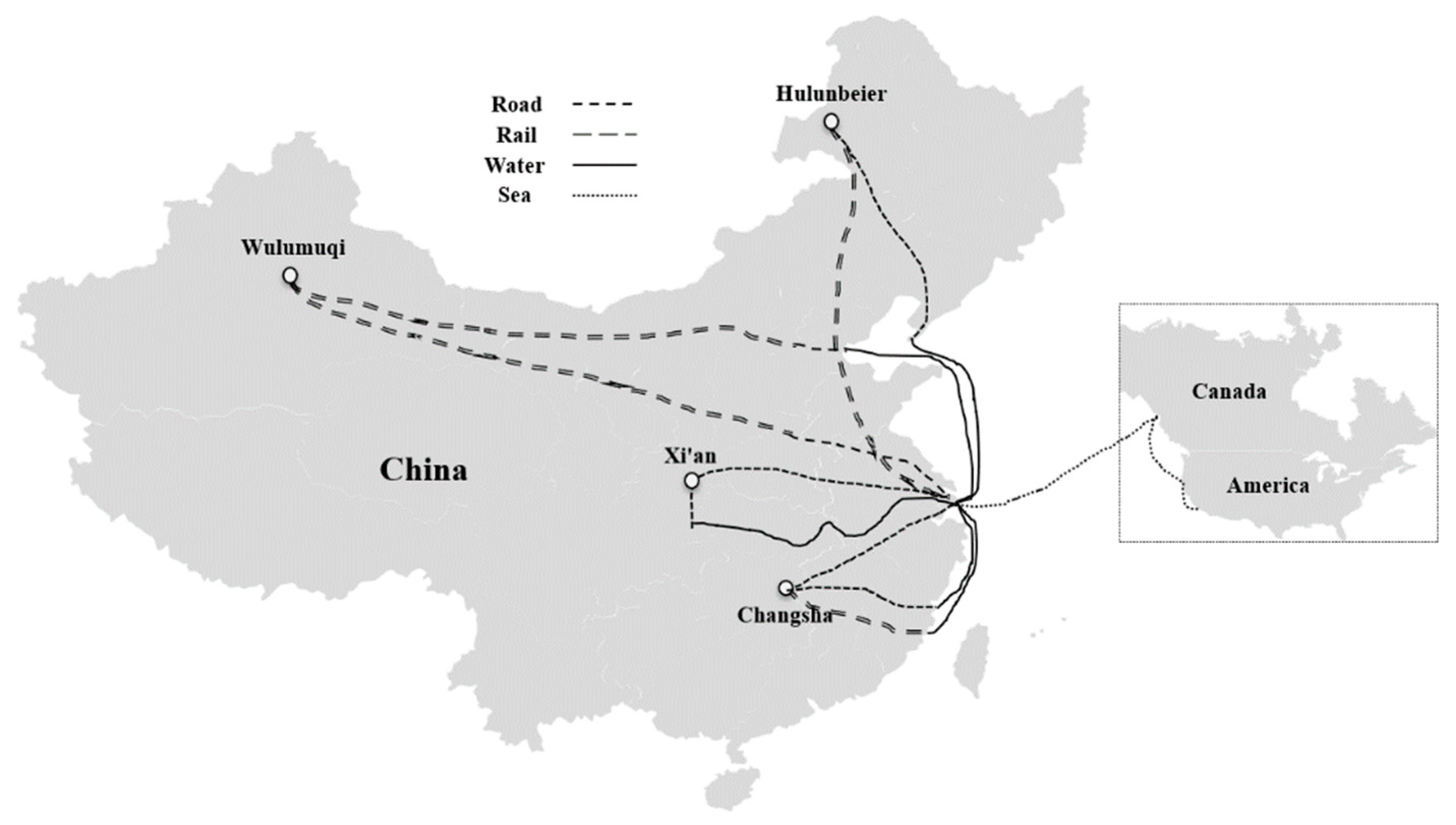
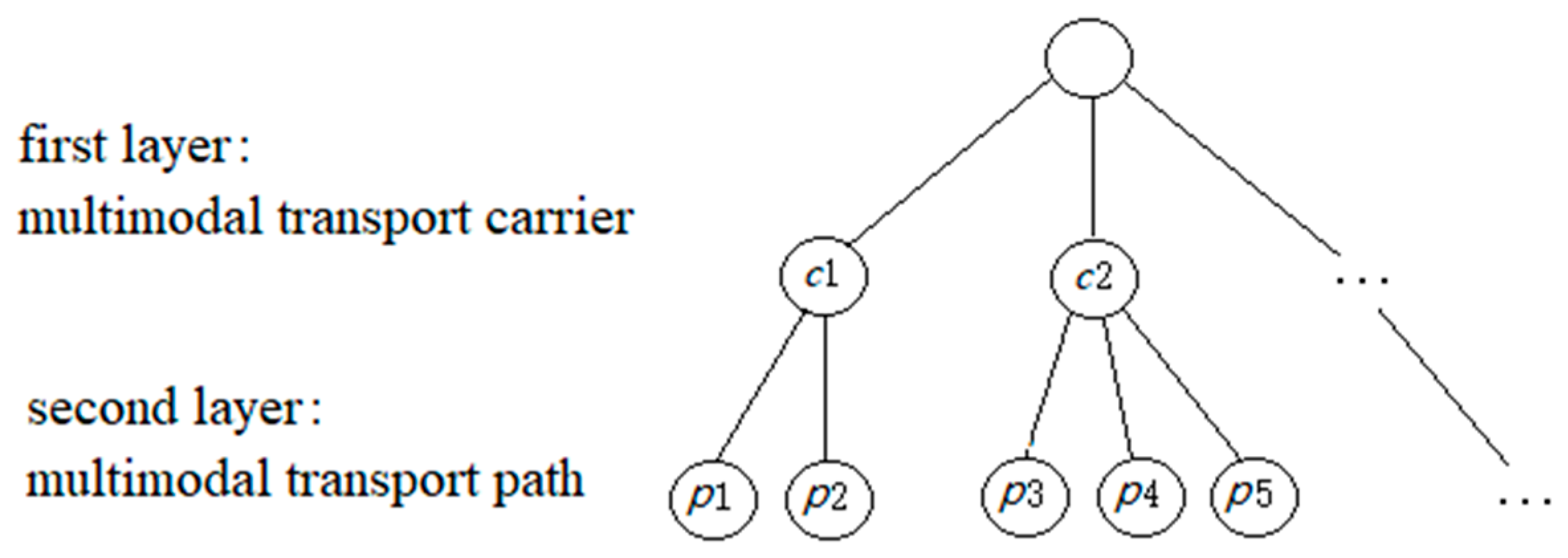
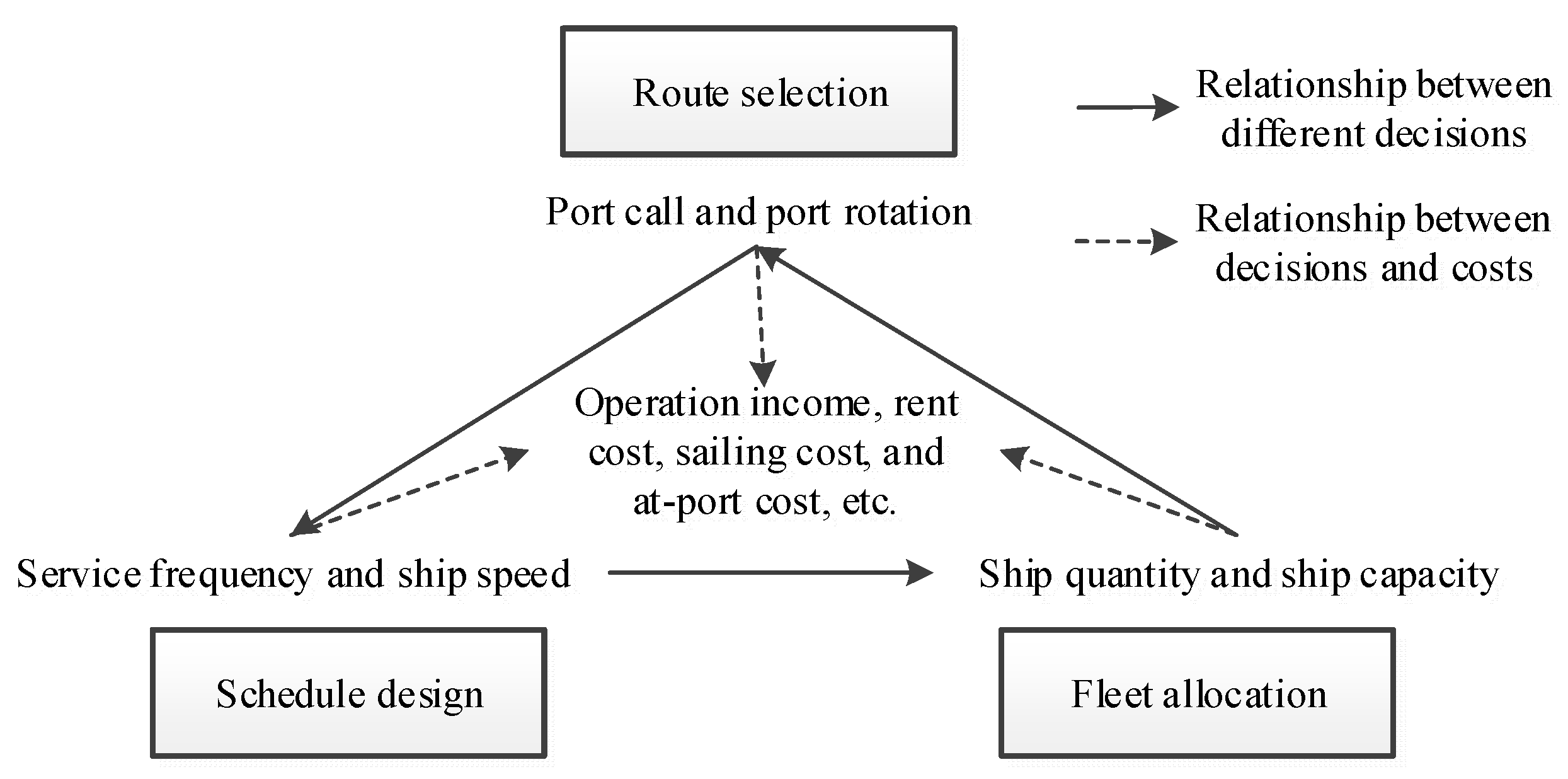
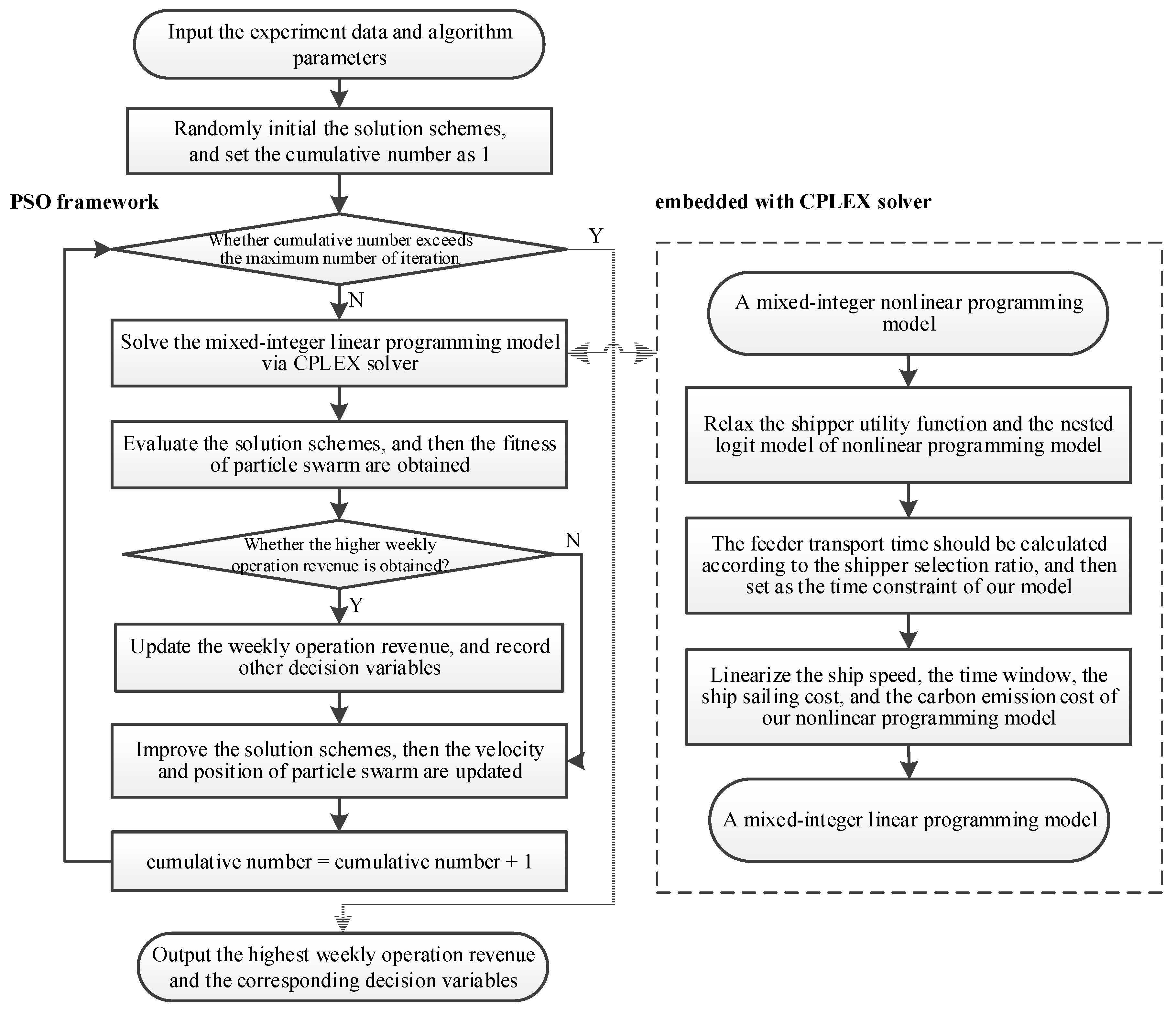




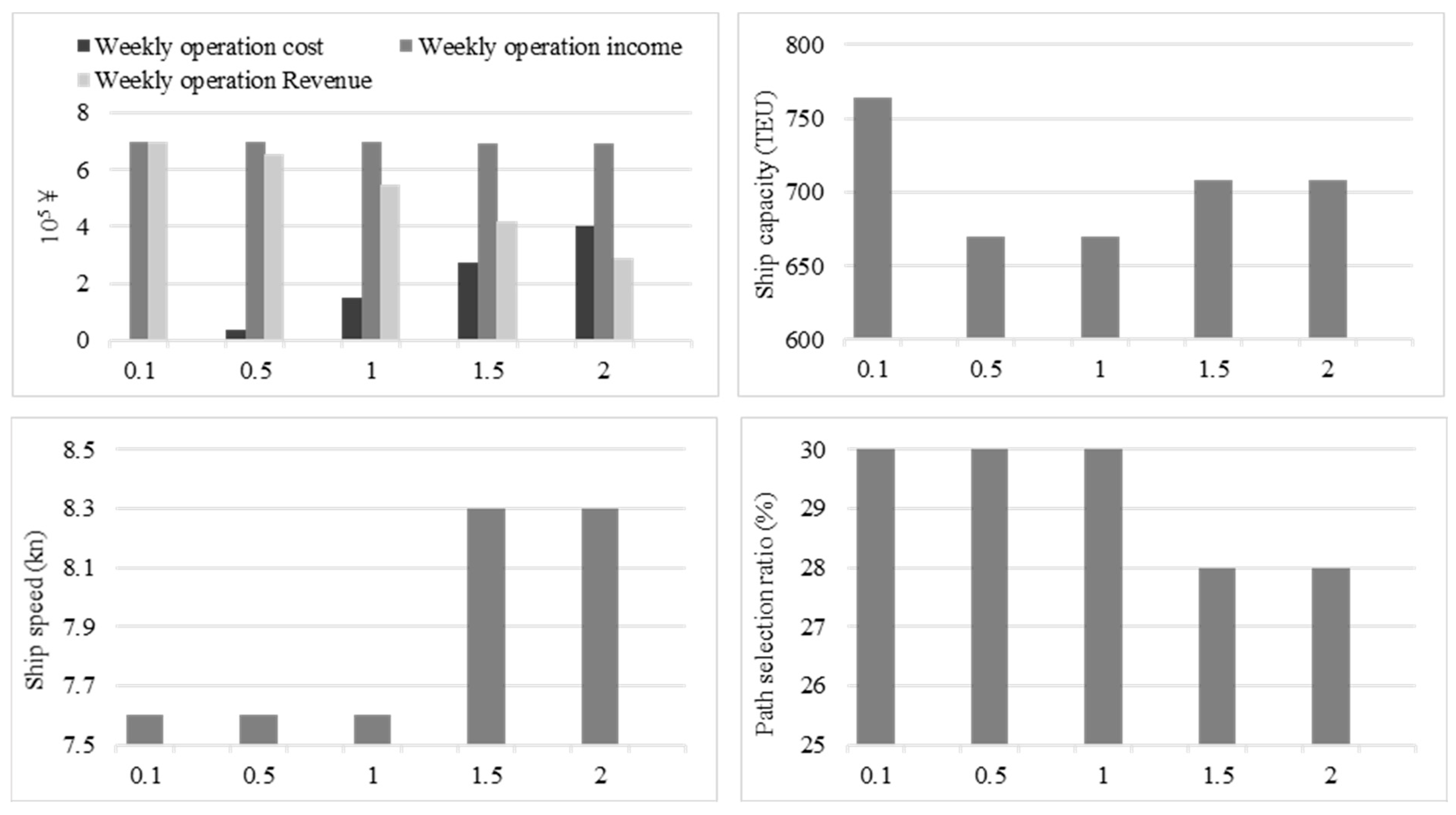
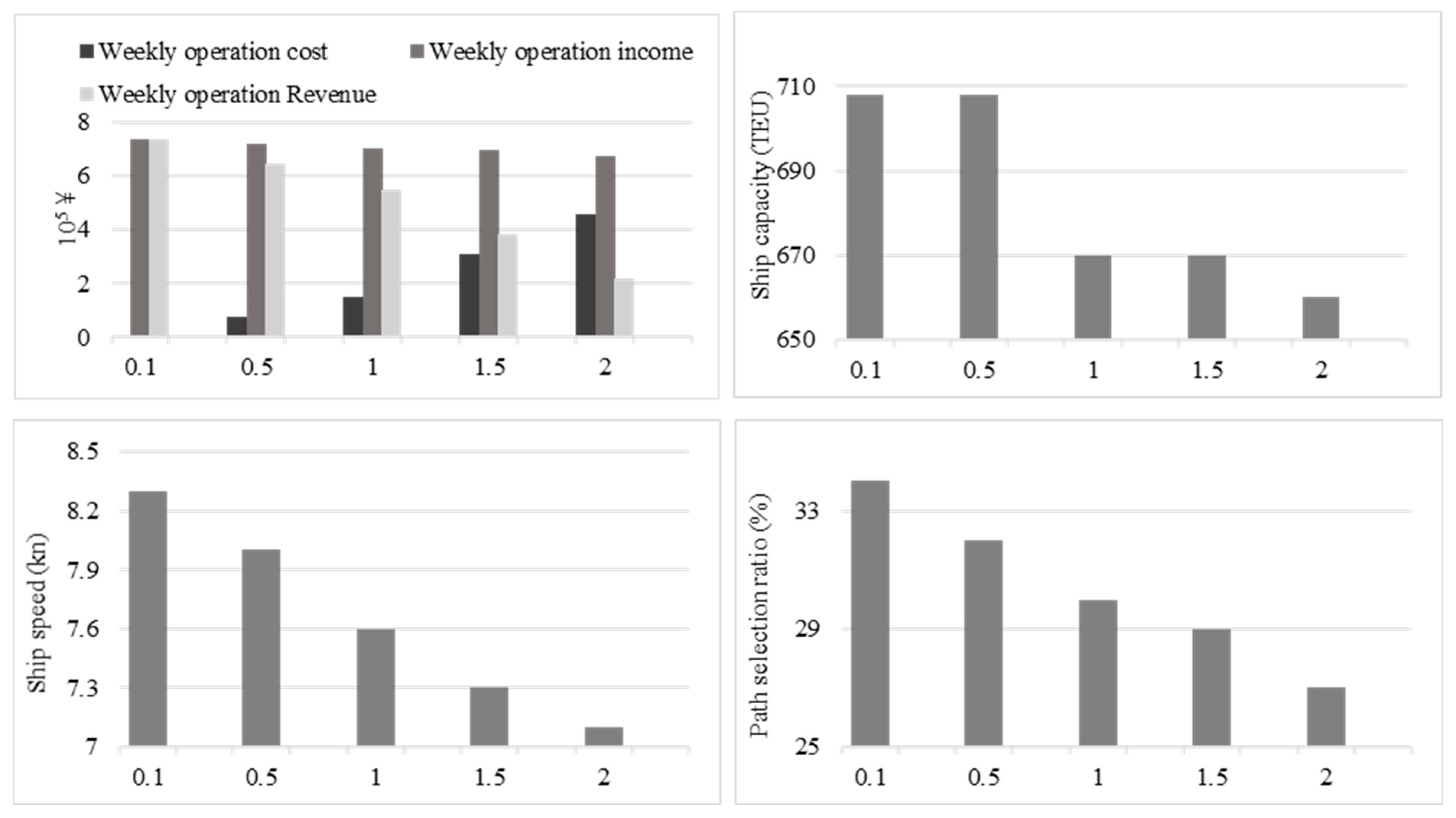
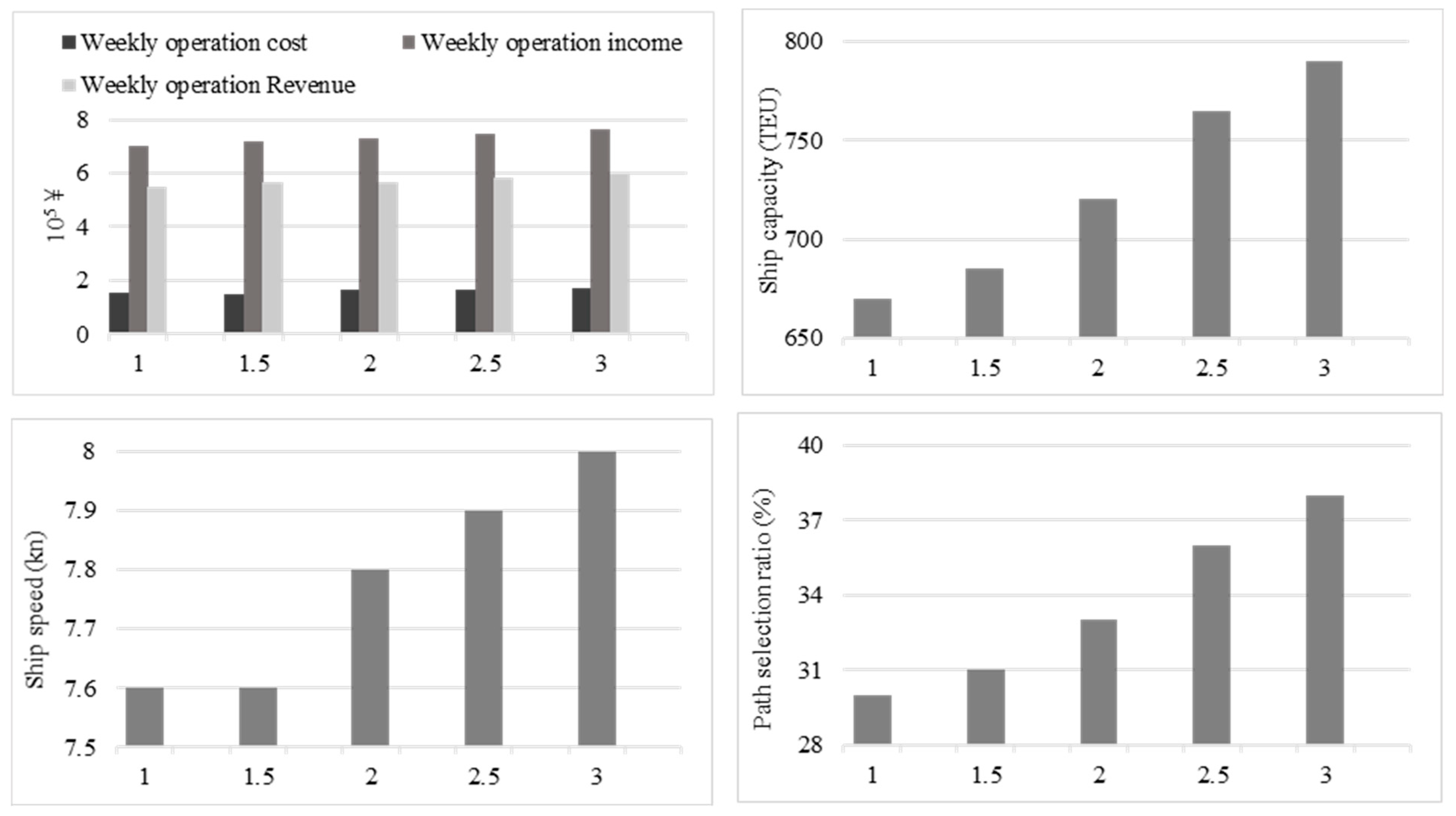
| Literature | Consideration of Shippers | Is It Door-to-Door? |
|---|---|---|
| Chen et al. (2014) [22] | Transport time and unit transport price | No |
| Wang et al. (2015) [23] | Transportation time, freight rate, and reputations | No |
| Kashiha et al. (2016) [24] | Geography and transportation costs | Yes |
| Yang et al. (2018) [25] | Total cost for delivering the cargoes | No |
| Tu et al. (2018) [9] | Travel time | No |
| Duan et al. (2019) [26] | Price, time, and reliability | No |
| Jiang et al. (2020a) [27] | Ship arrival time | No |
| Chen et al. (2020) [28] | Transportation cost | No |
| Zeng et al. (2020) [29] | Transportation time, freight rate, cargo damage rate, and convenience index | No |
| Cheng and Wang (2021) [10] | Shipping time and freight rate | No |
| Gao et al. (2022) [30] | Choice inertia | No |
| Du et al. (2023) [8] | Reputation, transportation time, freight rate, and ship arrival time | No |
| Subproblem | Objective | Input | Decision |
|---|---|---|---|
| Route selection | Minimize rent cost, sailing cost, and at-port cost | Alternate feeder routes | Port call and port rotation |
| Schedule design | Minimize sailing cost and at-port cost | Alternate service frequency and speed-adjustment interval | Service frequency and ship speed |
| Fleet allocation | Minimize rent cost | Alternate feeder ships | Ship quantity and ship capacity |
| Port | Import Demand (TEU) | Export Demand (TEU) |
|---|---|---|
| Harbin | 230 | 340 |
| Chifeng | 240 | 350 |
| Huhehaote | 250 | 260 |
| Taiyuan | 300 | 330 |
| Mode | City | Port | Mileage (km) |
|---|---|---|---|
| Rail | Harbin | Dalian | 1132 |
| Road | Harbin | Dandong | 830 |
| Rail | Chifeng | Dalian | 1158 |
| Road | Chifeng | Qinhuangdao | 423 |
| Road–rail | Huhehaote | Jingtang | 507, 950 |
| Road | Huhehaote | Qingdao | 1145 |
| Rail | Taiyuan | Huanghua | 660 |
| Road | Taiyuan | Qingdao | 540 |
| Index | Port call and Port Rotation | Service Frequency | Total Sailing Mileage of Ships | Sailing Mileage between Two Ports |
|---|---|---|---|---|
| 1 | Dalian–Dandong | 2 | 270 | 135 |
| 2 | Dalian–Yingkou | 2 | 312 | 156 |
| 3 | Dalian–Panjin | 2 | 408 | 204 |
| 4 | Dalian–Jinzhou | 2 | 440 | 220 |
| 5 | Dalian–Qinhuangdao | 2 | 336 | 168 |
| 6 | Dalian–Jingtang | 2 | 328 | 164 |
| 7 | Dalian–Tianjin | 2 | 440 | 220 |
| 8 | Dalian–Huanghua | 2 | 440 | 220 |
| 9 | Dalian–Weifang | 2 | 376 | 188 |
| 10 | Dalian–Longkou | 2 | 280 | 140 |
| 11 | Dalian–Yantai | 2 | 180 | 90 |
| 12 | Dalian–Yingkou–Panjin | 2 | 390 | 156-30 |
| 13 | Dalian–Jinzhou–Qinhuangdao | 2 | 558 | 220-170 |
| 14 | Dalian–Jingtang–Huanghua | 2 | 474 | 164-90 |
| 15 | Dalian–Weifang–Longkou–Yantai | 2 | 439 | 188-64-97 |
| 16 | Dalian–Yingkou–Panjin | 1 | 390 | 156-30 |
| 17 | Dalian–Jinzhou–Qinhuangdao | 1 | 558 | 220-170 |
| 18 | Dalian–Jingtang–Huanghua | 1 | 474 | 164-90 |
| 19 | Dalian–Weifang–Longkou–Yantai | 1 | 439 | 188-64-97 |
| 20 | Dalian–Yingkou–Panjin–Jinzhou | 2 | 486 | 156-30-80 |
| 21 | Dalian–Qinhuangdao–Jingtang–Huanghua | 2 | 546 | 168-68-90 |
| 22 | Dalian–Yingkou–Panjin–Jinzhou | 1 | 486 | 156-30-80 |
| 23 | Dalian–Qinhuangdao–Jingtang–Huanghua | 1 | 546 | 168-68-90 |
| 24 | Dalian–Yingkou–Panjin–Jinzhou–Qinhuangdao–Jingtang–Huanghua | 1 | 814 | 156-30-80-170-68-90 |
| 25 | Dalian–Yingkou–Panjin–Jinzhou–Qinhuangdao–Jingtang–Huanghua | 2 | 814 | 156-30-80-170-68-90 |
| Feeder Port | Freight Rate | Export Demand | Import Demand | Feeder Port | Freight Rate | Export Demand | Import Demand |
|---|---|---|---|---|---|---|---|
| Dandong | 215 | 210 | 150 | Tianjin | 350 | 45 | 30 |
| Yingkou | 248 | 180 | 165 | Huanghua | 350 | 75 | 90 |
| Panjin | 325 | 90 | 45 | Weifang | 299 | 90 | 75 |
| Jinzhou | 350 | 90 | 45 | Longkou | 223 | 60 | 90 |
| Qinhuangdao | 267 | 60 | 30 | Yantai | 143 | 135 | 150 |
| Jingtang | 261 | 45 | 30 |
| Instance | Calculation Time (s) | Objective Value (×105 CNY) | Maximum Fitness (×105 CNY) | Average Fitness (×105 CNY) | ||||
|---|---|---|---|---|---|---|---|---|
| Enumeration Method | PSO Framework | PSO Algorithm | Enumeration Method | PSO Framework | PSO Algorithm | PSO Framework | PSO Algorithm | |
| 2 × 13 × 7 | 35,200 | 2700 | 2900 | 2.97 | 2.97 | 2.24 | 1.78 | 0.65 |
| 2 × 13 × 14 | 36,400 | 2940 | 3120 | 3.01 | 3.00 | 2.39 | 1.92 | 0.71 |
| 2 × 25 × 7 | 37,500 | 3080 | 3330 | 3.18 | 3.18 | 2.43 | 2.01 | 0.78 |
| 2 × 25 × 14 | 38,100 | 3210 | 3520 | 3.32 | 3.30 | 2.51 | 2.06 | 0.81 |
| 4 × 13 × 7 | 61,300 | 3100 | 3400 | 3.70 | 3.69 | 2.80 | 2.24 | 0.95 |
| 4 × 13 × 14 | 64,800 | 3300 | 3600 | 3.74 | 3.74 | 2.81 | 2.31 | 0.97 |
| 4 × 25 × 7 | 68,200 | 3720 | 3820 | 3.77 | 3.77 | 2.83 | 2.38 | 0.98 |
| 4 × 25 × 14 | 71,900 | 3900 | 4100 | 3.81 | 3.79 | 2.86 | 2.43 | 1.01 |
| 6 × 13 × 7 | 143,000 | 3700 | 3900 | 3.94 | 3.93 | 2.96 | 2.99 | 1.07 |
| 6 × 13 × 14 | 152,000 | 3930 | 4120 | 4.02 | 4.00 | 3.09 | 3.06 | 1.09 |
| 6 × 25 × 7 | 167,000 | 4320 | 4360 | 4.15 | 4.13 | 3.21 | 3.16 | 1.11 |
| 6 × 25 × 14 | 171,000 | 4410 | 4520 | 4.32 | 4.31 | 3.32 | 3.25 | 1.12 |
| 8 × 13 × 7 | 219,200 | 4500 | 4600 | 4.97 | 4.97 | 3.41 | 3.57 | 1.15 |
| 8 × 13 × 14 | 246,000 | 4950 | 5000 | 5.05 | 5.03 | 3.47 | 3.61 | 1.21 |
| 8 × 25 × 7 | >259,200 | 5300 | 5400 | - | 5.09 | 3.48 | 3.69 | 1.28 |
| 8 × 25 × 14 | >259,200 | 5700 | 5900 | - | 5.13 | 3.51 | 3.75 | 1.31 |
| Index | Port calls and Port Rotation | Service Frequency | Round-Trip Time (h) | Ship Capacity (TEU) | Ship Speed (kn) |
|---|---|---|---|---|---|
| 1 | Dalian–Dandong | 2 | 56 | 900 | 8.7 |
| 2 | Dalian–Yingkou–Panjin | 1 | 137 | 650 | 10.8 |
| 3 | Dalian–Jinzhou | 2 | 57 | 650 | 9.1 |
| 4 | Dalian–Qinhuangdao | 2 | 53 | 900 | 8.7 |
| 5 | Dalian–Jingtang | 2 | 60 | 810 | 11.0 |
| 6 | Dalian–Tianjin | 2 | 51 | 650 | 7.3 |
| 7 | Dalian–Huanghua | 2 | 60 | 400 | 9.4 |
| 8 | Dalian–Weifang | 2 | 59 | 400 | 7.2 |
| 9 | Dalian–Longkou | 2 | 53 | 400 | 7.0 |
| 10 | Dalian–Yantai | 2 | 51 | 650 | 11.6 |
| Parameters | Route Index |
|---|---|
| 0.1α1 | 1/5/7/9/10/11/18/20 |
| 0.5α1 | 1/5/7/9/10/11/18/20 |
| 1.0α1 | 1/5/7/9/10/11/18/20 |
| 1.5α1 | 1/7/9/10/11/20/21 |
| 2.0α1 | 1/7/9/10/11/20/21 |
| 0.1γ | 1/5/7/9/10/11/18/20 |
| 0.5γ | 1/5/7/9/10/11/18/20 |
| 1.0γ | 1/5/7/9/10/11/18/20 |
| 1.5γ | 1/5/7/9/10/11/18/20 |
| 2.0γ | 1/5/7/9/10/11/18/20 |
| Parameters | Route Index |
|---|---|
| 1.0 | 1/5/7/9/10/11/18/20 |
| 1.5 | 1/5/7/9/10/11/18/20 |
| 2.0 | 1/5/7/9/10/11/18/20 |
| 2.5 | 1/5/7/9/10/11/18/20 |
| 3.0 | 1/5/7/9/10/11/18/20 |
Disclaimer/Publisher’s Note: The statements, opinions and data contained in all publications are solely those of the individual author(s) and contributor(s) and not of MDPI and/or the editor(s). MDPI and/or the editor(s) disclaim responsibility for any injury to people or property resulting from any ideas, methods, instructions or products referred to in the content. |
© 2023 by the authors. Licensee MDPI, Basel, Switzerland. This article is an open access article distributed under the terms and conditions of the Creative Commons Attribution (CC BY) license (https://creativecommons.org/licenses/by/4.0/).
Share and Cite
Guo, L.; Du, J.; Zheng, J.; He, N. Integrated Planning of Feeder Route Selection, Schedule Design, and Fleet Allocation with Multimodal Transport Path Selection Considered. J. Mar. Sci. Eng. 2023, 11, 1445. https://doi.org/10.3390/jmse11071445
Guo L, Du J, Zheng J, He N. Integrated Planning of Feeder Route Selection, Schedule Design, and Fleet Allocation with Multimodal Transport Path Selection Considered. Journal of Marine Science and Engineering. 2023; 11(7):1445. https://doi.org/10.3390/jmse11071445
Chicago/Turabian StyleGuo, Liming, Jian Du, Jianfeng Zheng, and Nan He. 2023. "Integrated Planning of Feeder Route Selection, Schedule Design, and Fleet Allocation with Multimodal Transport Path Selection Considered" Journal of Marine Science and Engineering 11, no. 7: 1445. https://doi.org/10.3390/jmse11071445
APA StyleGuo, L., Du, J., Zheng, J., & He, N. (2023). Integrated Planning of Feeder Route Selection, Schedule Design, and Fleet Allocation with Multimodal Transport Path Selection Considered. Journal of Marine Science and Engineering, 11(7), 1445. https://doi.org/10.3390/jmse11071445







